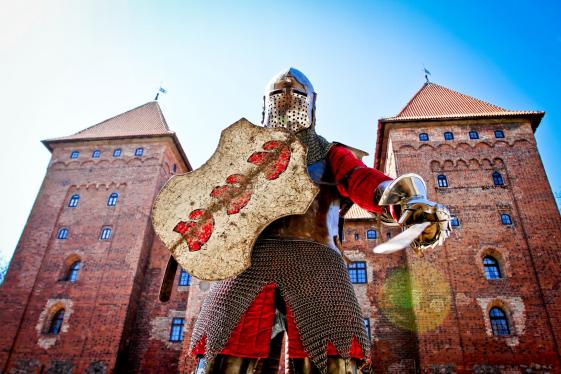October
Cittaslow: From Idea To Revitalization

From the beginning of its operation, it refers to better use of local resources: culinary traditions, local culture and monuments. Being 'slow' does not mean lagging behind. Supporters of the Slow movement call for slowing down the pace of life in order to cultivate relationships with the loved ones, with the local community and with their small homeland.
A few years ago, the symbol of the International Cittaslow Cities Association - the orange snail was completely unrecognizable in Poland. Today, Polish towns belonging to the network are considered as the most active Polish local governments. They effectively fit into regional strategies and European trends. They change their cities in accordance with the ideas of the "Slow" movement.
Appreciation of the development potential of small towns is a trend of the 21st century. It is an excellent illustration of the implementation of the sustainable development postulates. In a faster and faster world, Cittaslow Network member cities want to base their future on what is local and specific to their neighbourhood. Ecology and history – they are the key to maintaining solidarity with the past and the future generations. The Cittaslow network does not prevent members from the use of new, innovative technologies, but encourage to use them in a way that makes the cities better places to live for their inhabitants and visitors.
The idea of Cittaslow was discussed in the Warmian-Masurian region (Poland) already at early stage of its development. As early as in 2004, representatives of the voivodeship self-government and the city of Reszel signed up for the movement. A year later, four cities joined Cittaslow: Reszel, Biskupiec, Bisztynek and Lidzbark Warmiński, and the provincial government became a supporting member. Since then, the number of member-cities has been growing steadily. Although it is dominated by cities from Warmia and Mazury (there are 26 of them), currently also nine towns from other regions of Poland are part of the Cittaslow network.
Many years of cooperation within the movement resulted in the joint preparation of the Cittaslow city development program from the Warmia and Mazury region. It happened in 2015, when, thanks to good cooperation, the Supralocal Program for the Revitalization of the Cittaslow Cities Network was prepared. It is a unique program on the entire EU scale, defining the social revitalization of small towns in one of the poorest regions of Europe. The idea was in line with the assumptions of the regional development strategy and the Regional Operational Program for the Warmian-Masurian Voivodeship. The activities covered by the Program were supported by funds from the EU budget. The road to EU funds was long, but it was worth taking up these challenges. The effects of the Program are the best proof of it. The towns gained modern, refurbished, well-kept streets, squares, parks, and facilities for recreation and relaxation.New cultural institutions were created, and they are often located in historic buildings. These institutions are used in the most difficult aspect of urban development, i.e., social revitalization. All completed investments serve the integration of residents and their broadly understood activation. The serve especially the excluded groups and those in need of additional support.
The supralocal Program for the Revitalization of the Cittaslow Town Network in the Warmian-Masurian Voivodeship at a glance:
- The development of a Supra-Local Revitalization Program for 19 cities was a pilot action, not implemented before in any region of Poland.
- In order to implement such a complex undertaking in a consistent manner, it was necessary to appoint an entity acting as the program coordinator. It is the "Polish Cittaslow Cities" Association established on the basis of the Polish National Cittaslow Cities Network. The association has been operating since March 2015.
- The program includes 89 projects implemented in 19 Polish cities from the Warmia and Mazury region. These are projects concerning both revitalization investments, investments in cultural institutions, activities aimed at the protection of natural heritage combined with its sustainable use for the purposes of recreation and tourism. But these are also projects aimed at improving access to social services or increasing professional activity, and above all, the social integration of local communities. Program financing - EUR 44.7 million from the European Regional Development Fund and EUR 6.4 million from the European Social Fund and over EUR 10 million from municipalities' own funds.
- Some projects are already completed, the last ones will end in 2023.
- One of the most interesting are:
- Lubawa - revitalization of the city center and creation of a Social Activity Center at the reconstructed Chełmno Bishops' Castle;
- Lidzbark Warmiński - development of the banks of the Łyna river;
- Olsztynek - renovation and modernization of the historic water tower;
- Pasym - reconstruction of the Old Town Square - creation of a social integration and activation zone;
- Nowe Miasto Lubawskie - comprehensive renovation and reconstruction of the building of the Municipal Cultural Center to create a Manufacture of Old Professions
- Nidzica - reconstruction of the park by the city lake - arrangement of green areas in the neighbourhood of the park
Cities of Cittaslow - cities of good quality of life are a constantly developing movement. The pace and directions of this development are appreciated by the European Commission, which promotes cooperation networks and exchange of good practices. The program implemented in Warmia and Mazury also gained positive opinions from the European Commission, especially due to the great emphasis placed on the social aspect of revitalization. The international nature of the Cittaslow network is also important. Thanks to this, joint promotional and educational activities are implemented, both at the national and international level.